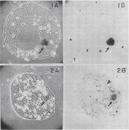« Prev Next »
During the mid-1950s, the connection between DNA, RNA, and protein was still fuzzy. RNA had been detected in both cytoplasm and nuclei, raising the question as to where this substance was synthesized, and from what. For example, was RNA made in the nucleus from DNA and then exported? Or was it made "from scratch" both inside and outside the nucleus by way of separate processes? Resolving such questions was an essential first step toward development of the proposal that RNA is synthesized directly from DNA in the nucleus, then exported to the cytoplasm as a messenger RNA (mRNA). But how exactly did researchers determine that RNA was of nuclear origin?
Observing RNA Synthesis
A simple way to determine where something comes from is to watch it arrive at its destination. In the 1950s, however, live imaging of RNA synthesis presented a number of challenges. At that time, researchers had developed techniques that allowed them to label RNA with radioactive phosphates, which meant that they could visualize this RNA by preserving labeled samples in formaldehyde, then putting the samples in contact with film to produce autoradiographs. Using this method, the researchers noticed that radioactivity first appeared in cells' nuclei and only later in their cytoplasm. Many scientists believed these findings suggested that RNA must be made in the nucleus and then transported out into the cytoplasm. In contrast, other scientists suggested that these images actually meant that RNA was made in both locations, but merely at a faster rate in the nucleus. How, then, could researchers determine whether RNA actually moved from the nucleus to the cytoplasm?
Goldstein and Plaut’s Experiments in Amoebas
Eventually, biologists Lester Goldstein and Walter Plaut devised a clever strategy that allowed them to answer that very question through examination of the relationship between nuclear and cytoplasmic RNA in amoebas. Goldstein and Plaut began by labeling RNA with radioactivity using established techniques. Next, the duo employed micromanipulation to carefully remove an individual amoeba's nucleus and transfer it to an unlabeled, enucleated amoeba. They reasoned that if RNA originated in the nucleus, radioactivity would, at the end of the experiment, be detected in both nucleus and cytoplasm. In contrast, if RNA did not traffic from nucleus to cytoplasm, no radioactivity would be detected in the cytoplasm at the conclusion of the experiment.
Goldstein and Plaut followed the voyage of the radioactive RNA by taking samples at different times following the nuclear transfer, fixing the samples, and exposing the fixed samples to film to produce autoradiographs. Together, this series of images revealed the origin and destination of nuclear RNA. Importantly, at early time points, essentially all the radioactivity was detected within the nucleus (Figures 1A, B); then, at later time points, radioactivity was detected in the cytoplasm as well (Figures 2A, B). The radioactivity had therefore moved from the nucleus to the cytoplasm, strongly suggesting a nuclear origin for RNA.
The experiments of Goldstein and Plaut were consistent with the hypothesis that RNA is synthesized in the nucleus and then exported to the cytoplasm. The experiment did not, however, rule out the possibility that RNA is also made in the cytoplasm, although researchers do not currently believe this to be the case. Can you think of a way to test this hypothesis?
References and Recommended Reading
Goldstein, L., & Plaut, W. Evidence for nuclear synthesis of cytoplasmic ribose nucleic acid. Proceedings of the National Academy of Sciences 41, 874–880 (1955).




 Figures 1 & 2
Figures 1 & 2


























